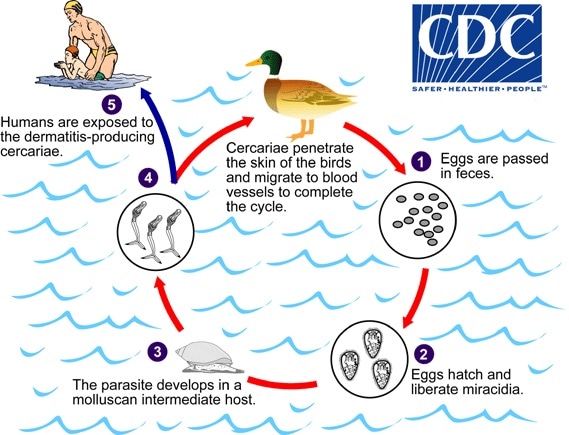What is Cercarial Dermatitis?
Cercarial dermatitis, also called swimmer’s itch, is a type of skin rash caused by allergic reactions to the larvae of non-human schistosomes, a parasitic flatworm, that usually infect birds and small mammals.
Common signs and symptoms of cercarial dermatitis include itchy skin, reddish pimples, and small blisters. These symptoms typically appear within minutes to days after swimming in contaminated water.
In most cases, cercarial dermatitis does not require any medical attention, and symptoms gradually go away within few weeks.
It is noncontagious and cannot be spread from one person to another. However, frequent and long-term swimming in contaminated water can increase the intensity of allergic reactions and induce more severe inflammatory reactions; if symptoms persist for more than three days and/or pus appears in the affected area, it is recommended to visit a skin specialist for medical help.

Lifecycle of Schistosomes
Adult schistosomes infect birds and small animals, such as ducks, gulls, swans, muskrats, and raccoons, and live in their bloodstream.
The eggs produced by parasites are passed in the feces of infected animals and subsequently enter the water.
These eggs are generally found in fresh water, and less commonly, in salt water. Afterward, eggs hatch in water and release microscopic, free-swimming larvae.
These larvae then swim in water and infect a specific species of snail that live near the shoreline. This is why cercarial dermatitis mainly develops after an exposure to shallow water.
These larvae grow and multiply inside snails, and infected snails release a different type of larvae (cercariae) into the water. These larvae swim in water and search for suitable hosts (animals and birds) to infect and continue their lifecycle.
Although humans are not a suitable host, cercariae can penetrate intact human skin within a few minutes and trigger allergic reactions.
Since cercariae can only penetrate the upper skin layer (epidermis) but cannot enter the bloodstream, they die very quickly.
Another type of dermatitis that has similar symptoms like cercarial dermatitis is sea-bather’s eruption, which is caused by larval forms of jellyfish. This infection occurs mainly in sea water and affects skin areas that are covered by clothing. In contrast, cercarial dermatitis mainly affects skin areas that are uncovered.
Risk Factors
There has been no reported differences in susceptibility between genders, but children may become infected more often due to children being more likely to swim and bathe in shallow waters for long periods of time, where cercariae are common. Some reported stimuli for penetration include linoleic and linolenic acids, which are found in sun creams.
Regularly swimming, bathing or working in fresh water environments can also increase a person’s chances of contracting cercarial dermatitis.
Treatment
Certain steps that should be followed to prevent the occurrence of cercarial dermatitis include:
- Avoid swimming in water which is known to be infected by cercariae.
- Avoid swimming in shallow water.
- Avoid feeding birds or animals near the swimming area.
- Take a bath immediately after leaving the water.
Diagnosis of cercarial dermatitis is somewhat difficult, as the symptoms are often similar to other skin problems. It is mainly done by checking the history of exposure and characteristic clinical features.
In most cases, cercariae infection immediately leads to a vascular reaction, which is characterized by the appearance of small reddish pimples. These pimples may turn into small blisters over time.
To control the itching sensation, oral antihistamines or corticosteroid creams are helpful. Besides, cool compresses to the affected area, taking bath in water containing baking soda, or applying baking soda paste to the rash can also help reducing the redness and itchy sensation of the skin.
Sources
- https://www.cdc.gov/parasites/swimmersitch/faqs.html
- https://www.dermnetnz.org/topics/swimmers-itch/
- www.mayoclinic.org/…/syc-20355043
- www.sciencedirect.com/…/cercarial-dermatitis
Further Reading
- All Cercarial Dermatitis Content
Last Updated: Feb 26, 2019

Written by
Dr. Sanchari Sinha Dutta
Dr. Sanchari Sinha Dutta is a science communicator who believes in spreading the power of science in every corner of the world. She has a Bachelor of Science (B.Sc.) degree and a Master's of Science (M.Sc.) in biology and human physiology. Following her Master's degree, Sanchari went on to study a Ph.D. in human physiology. She has authored more than 10 original research articles, all of which have been published in world renowned international journals.
Source: Read Full Article